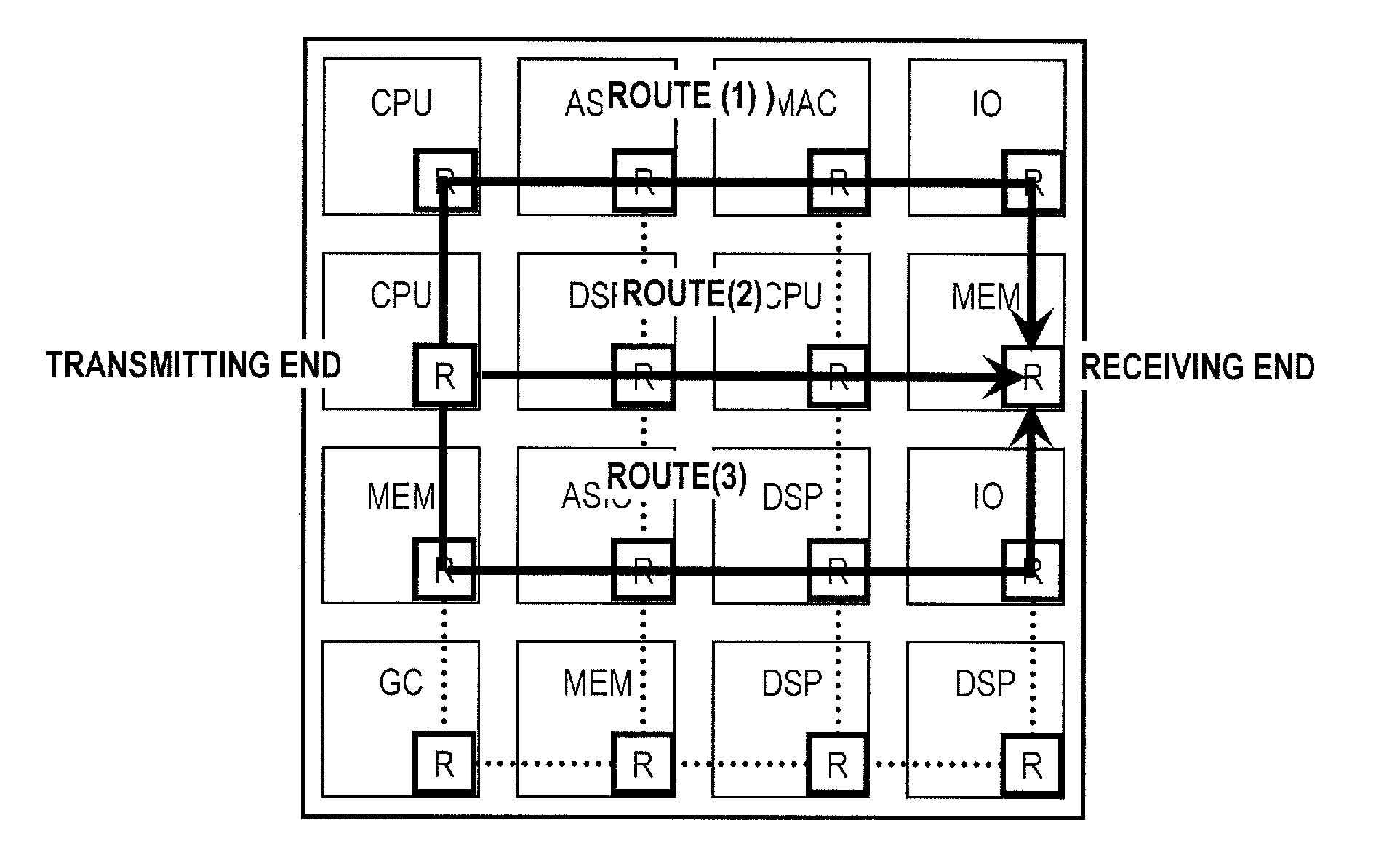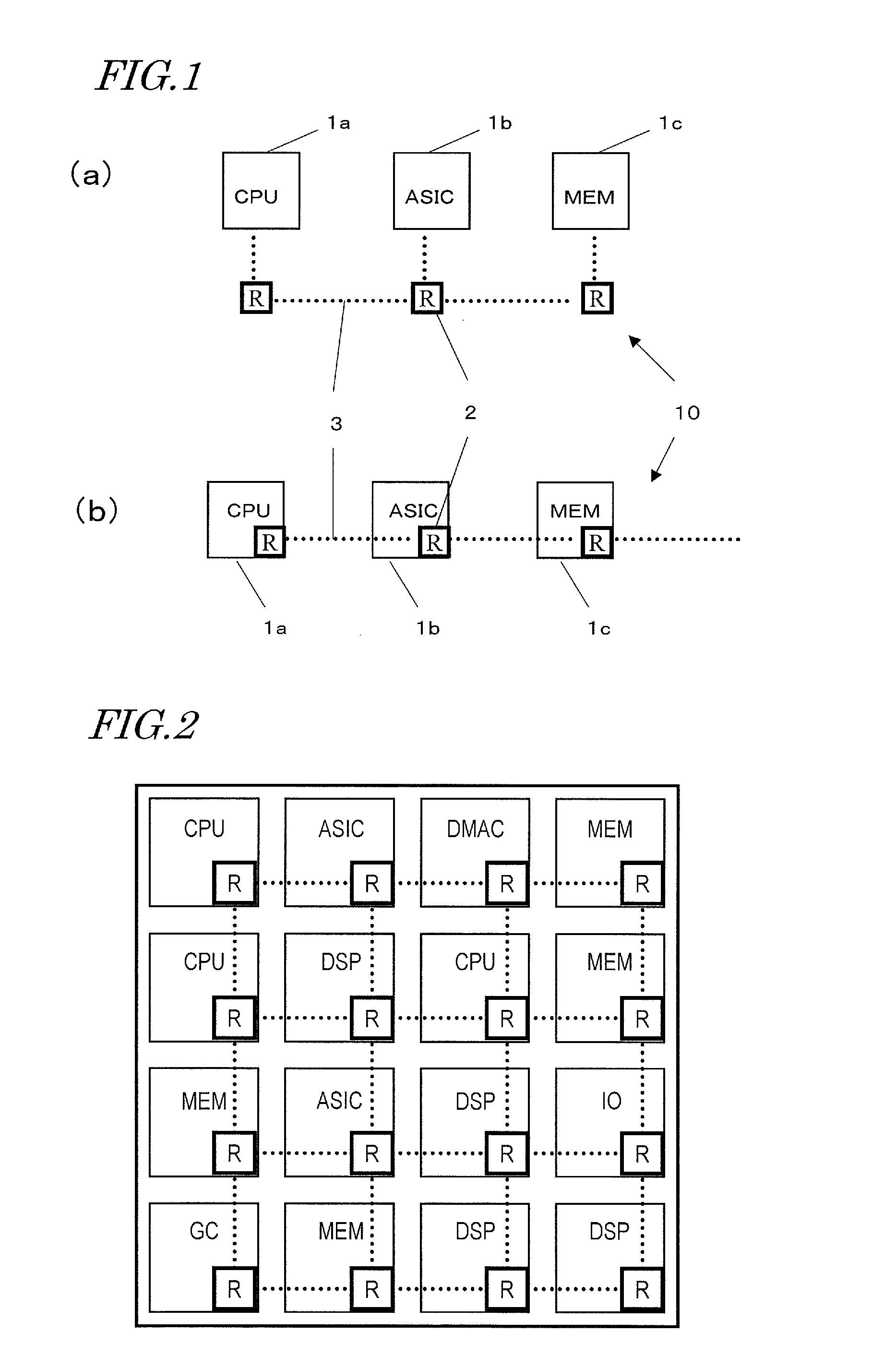Bus control device
a control device and bus technology, applied in the field of bus control devices, can solve the problems of increasing the number of bus masters connected to the communication bus on the chip, the complexity of traffic control to be done on the transfer data being transmitted and received through the bus, and the inability to achieve uniform data flow rate, etc., to achieve the effect of eliminating such non-uniform data flow ra
- Summary
- Abstract
- Description
- Claims
- Application Information
AI Technical Summary
Benefits of technology
Problems solved by technology
Method used
Image
Examples
embodiment 1
[0070]Before a bus controller as a first preferred embodiment of the present invention is described in detail, a so-called “NoC (Network on Chip)” communication bus, transmission routes that can be used on the communication bus, and the data transfer rates of the respective transmission routes will be described. In addition, it will also be described how in principle the bus controller of this preferred embodiment operates.
[0071]FIG. 5 illustrates how a system on chip semiconductor LSI to be built in cellphone terminals, for example, may be formed using an NoC bus. This drawing is also illustrated in the same format as FIG. 1(b). Although a bus controller R is connected one to one to each single bus master in FIG. 5, some bus controllers may just perform a relay function without being connected to any bus master.
[0072]If each bus controller R is connected to its associated bus master, each bus master is given a non-ambiguous address. On the other hand, if not every bus controller is...
embodiment 2
[0146]FIG. 20 illustrates an exemplary configuration in which the present invention is applied to a distributed memory architecture. In this arrangement, three processors UP11, UP12 and UP13 and three shared memory modules MEM31, MEM32 and MEM33 are connected together with a network of bus controllers that is implemented as a 3×3 mesh. Each of these processors allocates a memory space that is required when a task is started to one of these memory modules, and frees that memory space when the task gets done. However, if the memory spaces were allocated to a particular memory module so often, the access rates would be non-uniform between the memory modules, and the operating frequency on the access bus leading to that particular memory module would increase due to the excessive access, thus causing problems in terms of design and power dissipation. However, if the processor carries out the memory space allocation so that the access rates will be as uniform as possible between the memo...
embodiment 3
[0175]A bus controller as a third specific preferred embodiment of the present invention is also applicable to the distributed memory architecture shown in FIG. 20 as in the second preferred embodiment of the present invention described above. However, as such a distributed memory architecture has already been described for the second preferred embodiment, the description thereof will be omitted herein.
[0176]Each of the bus controllers that form the distributed memory network of this preferred embodiment has the same configuration as the bus controller 2 of the second preferred embodiment shown in FIG. 14 except the following respects. Thus, description of their common features will be omitted herein.
[0177]Route Load Detecting Section 101
[0178]In this preferred embodiment, Equation (16) adopted in the second preferred embodiment described above may be replaced with the following Equation (24):
ρi={1(max{β^i}=0)min{β^i}max{β^i}(otherwise)(24)
[0179]It is determined by the following Equ...
PUM
 Login to View More
Login to View More Abstract
Description
Claims
Application Information
 Login to View More
Login to View More - R&D
- Intellectual Property
- Life Sciences
- Materials
- Tech Scout
- Unparalleled Data Quality
- Higher Quality Content
- 60% Fewer Hallucinations
Browse by: Latest US Patents, China's latest patents, Technical Efficacy Thesaurus, Application Domain, Technology Topic, Popular Technical Reports.
© 2025 PatSnap. All rights reserved.Legal|Privacy policy|Modern Slavery Act Transparency Statement|Sitemap|About US| Contact US: help@patsnap.com



